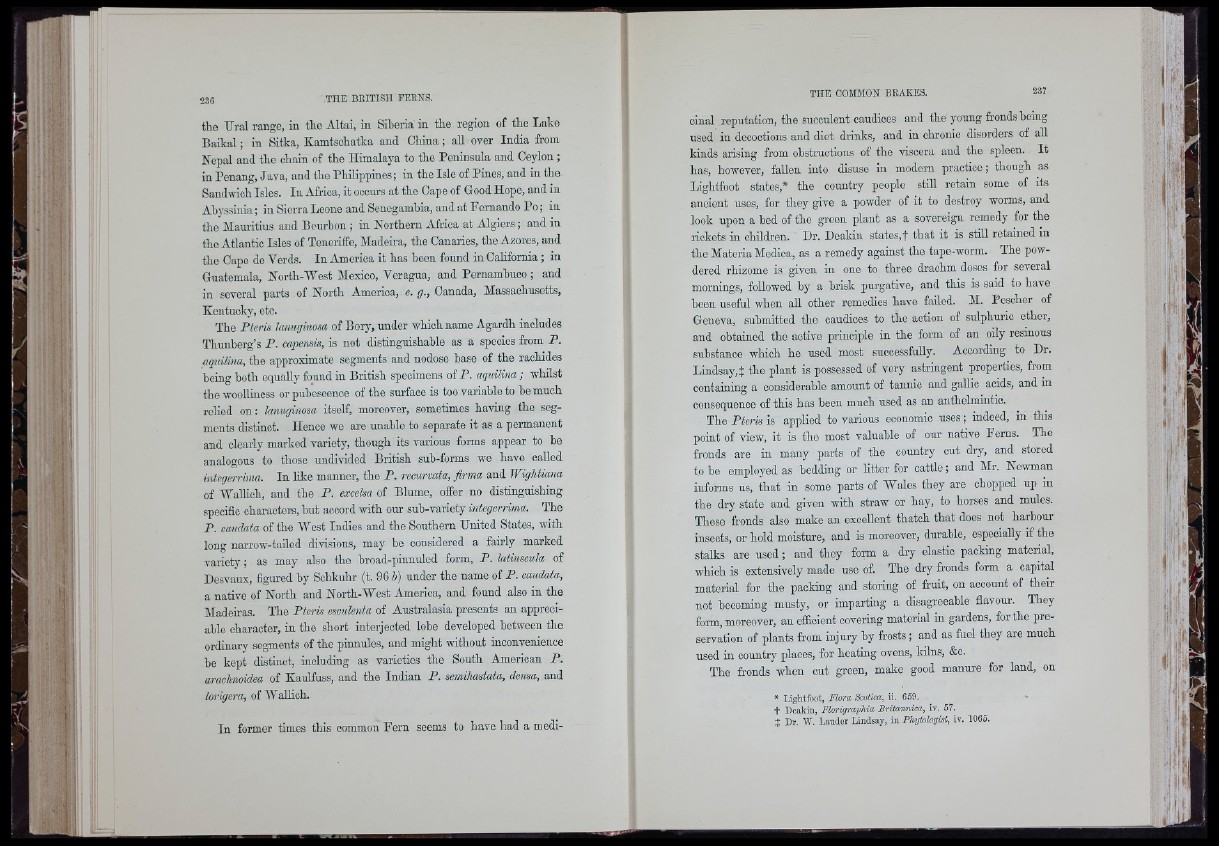
iii* I
Ilb
■ tI
Inii
if
’ •U?'? i;
:i
'ii•V(II
• ti'j
the Ural range, in the Altai, in Siberia in the region of the Lake
Baikal; in Sitka, Kamtschatka and China; all over India from
Nepal and the chain of the Himalaya to the Poninsula and Ceylon ;
in Penang, Java, and the Philippines; in the Isle of Pines, and in the
Sandwich Isles. In Africa, it occurs at the Cape of Good Hope, and in
Ahj/ssinia; in Sierra Leone and Senegambia, and at Fernando Po; in
tho Mauritius and Bourbon ; in Northern Africa at Algiers; and m
the Atlantic Isles of Tenoriffe, Madeira, the Canaries, the Azores, and
the Cape do Verds. In America it has been found in California ; in
Guatemala, North-West Mexico, Yeragua, and Pernambuco; and
in several parts of North America, e. g., Canada, Massachusetts,
Kentucky, etc.
The Pteris lanuginosa of Bory, under which name Agardh includes
Thunherg’s P. capensis, is not distmguishable as a species from P .
aquilina, the approximate segments and nodose base of the rachides
being both equally found in British specimens of P. aquilina; whilst
the woollincss or pubescence of the surface is too variable to be much
relied on: lanuginosa itself, moreover, sometimes having the segments
distinct. Hence we are unable to separate it as a permanent
aud clearly marked variety, though its various forms appear to be
analogous to those undivided British sub-forms we have called
intcgerrima. In like manner, tho P . recurmta, firma and Wightiana
of Wallich, and the P . excelsa of Blume, offer no distiuguishing
specific characters, hut accord with our sub-variety integerrima. The
P. caudata of the West Indies and the Southern United States, with
long narrow-tailed divisions, may be considered a fairly marked
variety; as may also the broad-pinnuled form, P . latiuscula of
Desvaux, figured by Schkuhr (t. 96 i) under the name of P. caudata,
a native of North and North-West America, and found also in the
Madeiras. The Pteris esculenta of Australasia presents an appreciable
character, in the short interjected lobe developed between the
ordinary segments of the pinnules, and might without inconvenience
be kept distinct, including as varieties the South American P.
araehnoidea of Kaulfuss, and tho Indian P . scmihastata, densa, and
lorigera, of Wallich.
In former times this common Fern socms to have had a medioinal
reputation, the succulent oaudioes and the young fronds hoing
used in decoctions and diet drinks, and in chronic disorders of all
kinds arising from ohstruotious of tho viscera and the spleen. It
has, however, fallen into disuse in modem practice; though as
Lightfoot states,* the country people still retain some of its
ancient uses, for thoy give a powder of it to destroy worms, and
look upon a bed of the green plant as a sovereign remedy for the
rickets in children. Dr. Deakin states,! that it is still retained in
the Materia Modioa, as a remedy against the tape-worm. The powdered
rhizome is given in one to three drachm doses for several
mornings, followed by a brisk purgative, and this is said to have
been useful when all other remedies have failed. M. Pescher of
Geneva, submitted the caudioos to the action of sulphuric ether,
and obtained the active principle in the form of an oily resinous
substance which he used most successfully. According to Dr.
Lindsay,! the plant is possessed of very astringent properties, from
containing a considerable amount of tannic and gallic acids, and in
consequence of this has been much used as an antholmmtie.
The Pteris is applied to various economic uses; indeed, in this
point of view, it is tho most valuable of our native Ferns. The
fronds are in many parts of the country cut dry, and stored
to he employed as bedding or litter for cattle; and Mr. Is owman
informs us, that in some parts of Wales they aro chopped up in
the dry state and given with straw or hay, to horses and mules.
These fronds also make an excellent thatch that does not harbour
insects, or hold moisture, and is moreover, durable, especiaUy if the
stalks are used; and they form a dry elastic packing material,
which is extensively made use of. The dry fronds form a capital
material for the packing and storing of fruit, on account of their
not beooming musty, or imparting a disagreeable flavour. They
form, moreover, an efficient covering material in gardens, for the preservation
of plants from injury by frosts; and as fuel they are much
used iu country places, for heating ovens, kilns, &e.
The fronds when cut green, make good manure for land, on
♦ Lightfoot, F lo ra Smtim, ii. 659.
t Deakin, Florigraphia Britarmica, iv. 57.
i Dr. W. Lauder Lindsay, in Phytologist, iv. 1065.
iii'
frvi
4 At r
• i 1
. 'r i'
¡il
A.